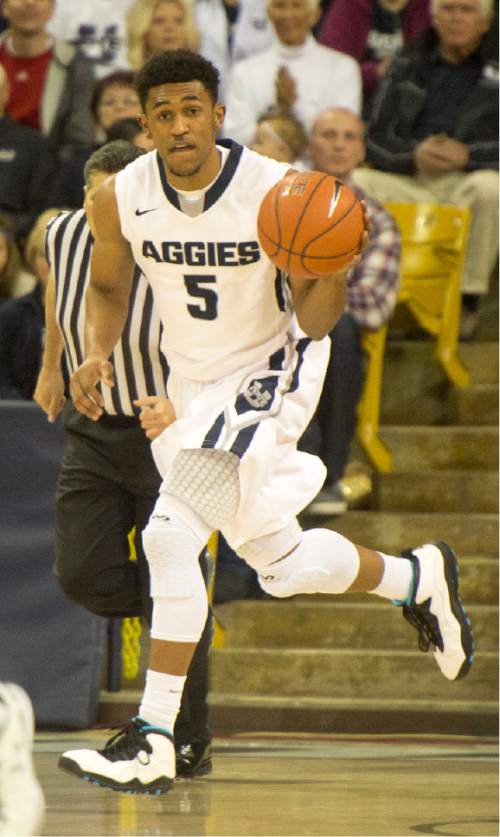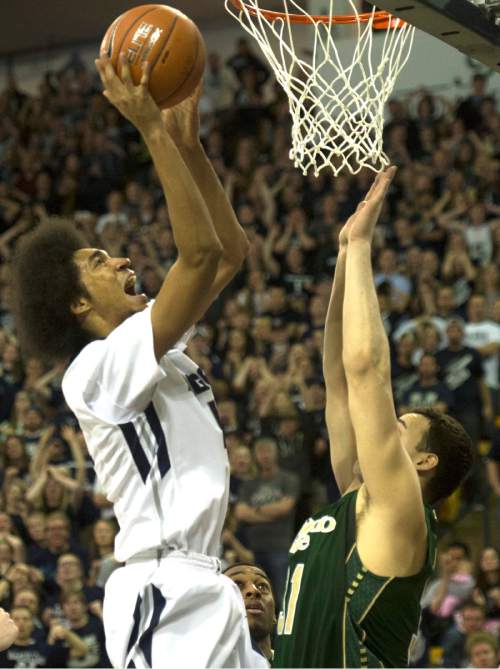This is an archived article that was published on sltrib.com in 2015, and information in the article may be outdated. It is provided only for personal research purposes and may not be reprinted.
Soon, all Utah taxpayers will be Utah State Aggie boosters.
Utah State University's efforts to recruit football players, basketball players and other athletes are getting a $1.5 million infusion from taxpayers under language included in the newly approved state budget by Senate Budget Chairman Lyle Hillyard, R-Logan.
Hillyard made his pitch for the funding, arguing that, due to a recent NCAA rule change, college athletics programs across the country were beginning to pay athletes a stipend, in addition to the traditional tuition and housing that is covered in scholarships.
A contending Aggies team is good for Logan's economy, since people travel to the games, filling hotels and restaurants. But to compete for recruits, Utah State needed to be able to pay stipends to its players, too, and needed the state support to do so.
The Business, Economic Development and Labor budget subcommittee recommended giving $750,000 to the school next year, making the school come back after that for more.
But after final budget negotiations, Hillyard came away with $1.5 million in perpetuity for the program, labeled in the budget bill as "Utah Wellness Program."
"It obviously helped I'm the appropriations chair, but let me tell you, the House [leaders] came through" in supporting the budget item, Hillyard said.
—
Bad deal? • Maryann Martindale, executive director of the Alliance For a Better Utah, said supporting USU athletics doesn't seem like a good deal for taxpayers.
"Legislators have spent this entire session complaining about not having sufficient funds to support Medicaid expansion, to expand public-education funding, and many other worthy project, yet they seem to find money for pet projects," she said. "We all hope our favorite schools can recruit top talent but it does not seem like the appropriate use of public funds to support it with an appropriation of taxpayer money."
USU's slice of state money is part of a larger pie dished out for projects pitched as economic development.
All told, the budget committee doled out nearly $34 million in odds and ends for museums, theater groups, movie production and other activities.
The Big Outdoor Expo will receive $150,000 for a sportsmen's fair in Utah County to promote tourism. The Hale Centre Theatre will get $100,000 to pay actors, and the Centerpoint Legacy Theatre in Centerville and Tuacahn Center for the Arts in Southern Utah will receive a combined $325,000 to expand.
Lawmakers are forking over $100,000 for the Utah Restaurant Association's "Let's Eat Out" ad campaign, reminding people that Utah eateries have delicious food. The Utah Aviation Hall of Fame will receive $150,000 and the Sports Hall of Fame $50,000 to renovate displays.
The Hill Air Force Base Air Show is to get $100,000 to help sign performers for the 2016 show, which draws half a million people.
—
Keeping up with the neighbors • As for Utah State's athlete-recruitment efforts, Hillyard said he would have been happy with $750,000, or even less, but that changed in the last few days.
"Absolutely, when the state of Wyoming gave their university $4 million so they could compete on the same level, and I understand New Mexico has a bill pending to do the same thing and so does Nevada for Reno," Hillyard said.
All three schools compete in the Mountain West Conference with USU.
The NCAA changed its policy last August, allowing 65 schools from the power conferences — the ACC, Big 10, Big 12, Pac 12, and SEC — plus Notre Dame, to begin paying athletes stipends of a few thousand dollars for things like meals, clothing and some incidental expenses.
The University of Utah will begin paying the costs of attendance for student-athletes in the 2015-16 school year. It is expected to cost about $1 million and the school is currently raising money from boosters and private sources.
Because of federal requirements that women's college athletics have a level playing field with men's, the stipends would extend to several women's programs, as well.
Hillyard said the state is giving indirect support to the University of Utah's athletics program. When the school built its indoor practice facility, it did so with private donations, but then came to the Legislature for money to maintain and operate the building, which the Legislature agreed to, to the tune of $2 million a year.
Twitter: @RobertGehrke









